Remembering Pearl Harbor 2008
I write this as I look out my 29th floor hotel room in the direction of Pearl Harbor. My wife and I came to Oahu, Hawaii to celebrate our 29th anniversary on December 2nd. Although it is a coincidence that we are still here on December 7th, it still feels eerie. On Wednesday, we visited the USS Arizona Memorial, which was a moving experience. Arriving just before 7am to stand in line, the tour buses continued to unload groups behind us. We were in the first group to see the film that begins the journey to the wreck of the Arizona. Comprised solely of original footage, the film examines not only the attack itself but also its antecedents. It is entirely descriptive and remarkably fair. For example, it describes both the brutal Japanese invasion of China and the less frequently noted oil embargo imposed on Japan by the U.S. in response. It also candidly describes the various ways in which the US command was unprepared for and ignored warnings of the impending disaster. I cannot find that video on-line but here is another describing the attack using original Japanese and American footage of which a surprising amount exists.
After the film, the group somberly headed for the boat to take us to the Memorial which straddles the sunken Arizona. From the deck of the Memorial, one can see the base of a gun turret emerging from the water.
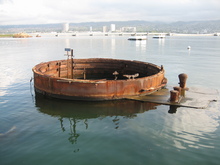
For some reason it is particularly disturbing to see the oil slick on the surface of the water; it is still oozing from the ship, which had been fully fueled when sunk. Three sailors briefly hoisted American flags taken from two Fed Ex boxes over the Memorial to be lowered, folded and returned to their senders.
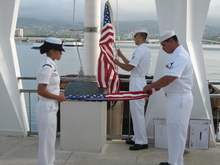
From the Memorial can be seen the USS Missouri, an Iowa class battleship a third larger than the Arizona, that was being built at the time of Pearl Harbor and on which the Japanese surrender was signed in Tokyo Bay. The guides refer to these as "bookends" marking the first and last days of WWII. Although not there during the attack, it is useful to see the ship close by because it conveys the size of the battleships that were lined up on December 7th, 1941 in way that cannot otherwise be imagined by looking at the open water of the harbor.
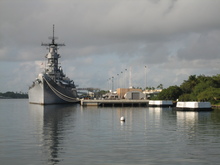
Our visit to the Memorial was a very quiet and emotional experience (click to enlarge picture).
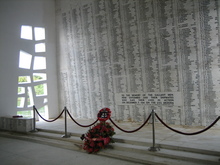
It is captured by the following video I located on YouTube:
In the visitor's center several survivors of the attack were seated at a table signing autographs. More than the usual number were there in advance of the annual ceremonies to take place on December 7th.
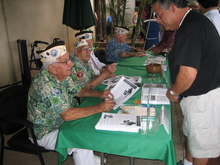
We then took a bus to the USS Missouri where we received what turned out to be a private tour of 5 levels of the ship. One reason I was interested in this tour was because I have seen Under Siege many times. Although I am no Stephen Seagal fan, I really like this film, maybe because Tommy Lee Jones and Gary Busey are such excellent bad guys. Before even starting the tour, however, I learned that the film was not shot on the Missouri, but on the USS Alabama. During the tour it became pretty obvious that none of the recognizable locations--such as the bridge or "Broadway"--looked anything like the film. This film shows the Missouri in action in the first Gulf War, including the loading of its 16 inch guns.
The tour culminated in the "surrender deck" where the Japanese command signed the articles of surrender. Reproductions of the articles were exhibited including the Japanese copy on which the Canadian representative had signed on the wrong line. As a result, several lines of typed names were crossed out and other names hand printed in and initialed. Even the ends of wars are not without errors. Here is a contemporary newsreel describing the ceremony.
The Missouri--Big Mo--is privately operated and maintained. The website can be found here.
After the film, the group somberly headed for the boat to take us to the Memorial which straddles the sunken Arizona. From the deck of the Memorial, one can see the base of a gun turret emerging from the water.
For some reason it is particularly disturbing to see the oil slick on the surface of the water; it is still oozing from the ship, which had been fully fueled when sunk. Three sailors briefly hoisted American flags taken from two Fed Ex boxes over the Memorial to be lowered, folded and returned to their senders.
From the Memorial can be seen the USS Missouri, an Iowa class battleship a third larger than the Arizona, that was being built at the time of Pearl Harbor and on which the Japanese surrender was signed in Tokyo Bay. The guides refer to these as "bookends" marking the first and last days of WWII. Although not there during the attack, it is useful to see the ship close by because it conveys the size of the battleships that were lined up on December 7th, 1941 in way that cannot otherwise be imagined by looking at the open water of the harbor.
Our visit to the Memorial was a very quiet and emotional experience (click to enlarge picture).
It is captured by the following video I located on YouTube:
In the visitor's center several survivors of the attack were seated at a table signing autographs. More than the usual number were there in advance of the annual ceremonies to take place on December 7th.
We then took a bus to the USS Missouri where we received what turned out to be a private tour of 5 levels of the ship. One reason I was interested in this tour was because I have seen Under Siege many times. Although I am no Stephen Seagal fan, I really like this film, maybe because Tommy Lee Jones and Gary Busey are such excellent bad guys. Before even starting the tour, however, I learned that the film was not shot on the Missouri, but on the USS Alabama. During the tour it became pretty obvious that none of the recognizable locations--such as the bridge or "Broadway"--looked anything like the film. This film shows the Missouri in action in the first Gulf War, including the loading of its 16 inch guns.
The tour culminated in the "surrender deck" where the Japanese command signed the articles of surrender. Reproductions of the articles were exhibited including the Japanese copy on which the Canadian representative had signed on the wrong line. As a result, several lines of typed names were crossed out and other names hand printed in and initialed. Even the ends of wars are not without errors. Here is a contemporary newsreel describing the ceremony.
The Missouri--Big Mo--is privately operated and maintained. The website can be found here.